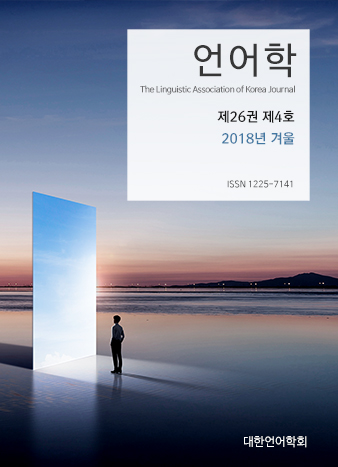대한언어학회 전자저널

-
L1 Interference in Koreans' Perception of Released Word-final Stops in English
-
Perceptual Similarity between English and Korean: Evidence from Online Adaptation
-
A Study on the Definite Article in English Based on the Rasch Model
-
Phonetic Resurrection from Ellipsis Sites: A Case from Pseudo-gapping
-
A Study of the Content Validity of Reading Comprehension Tests in NMET II
-
Labeling, Cartography, and the Left-periphery of Korean Clauses
26권 4호 (2018년 12월)
- L1 Interference in Koreans' Perception of Released Word-final Stops in English
-
Hyunsook Kang
Pages : 1-20
Abstract
Keywords
# L1 interference # perception # released word-final stops in English # conflicting cues # release bursts
References
- Best, C., McRoberts, G., & Sithole, N. (1988). The phonological basis of perceptual loss for non-native contrasts: Maintenance of discrimination among Zulu clicks by English-speaking adults and infants. Journal of Experimental Psychology: Human Perception and Performance, 14, 345-360.
- Burnham, D. (1986). Developmental loss of speech perception: Exposure to and experience with a first language. Applied Psycholinguistics, 7, 207–240.
- Byrd, D. (1993). 54,000 American stops. UCLA working Papers in Phonetics, 83, 97-116.
- Crowther, C., & Mann, V. (1992). Native language factors affecting use of vocalic cues to final consonant voicing in English. Journal of the Acoustical Society of America, 92, 711-722.
- Goto, H. (1971). Auditory perception by normal Japanese adults of the sounds “L” and “R”. Neuropsychologia, 9, 317-323.
- Han, J. (1996). The phonetics and phonology of “tense” and “plain” consonants in Korean. Unpublished doctoral dissertation, Cornell University, NY.
- Han, M., & Weitzman, R. (1970). Acoustic features of Korean /P, T, K/, /p, t, k/, /ph, th, kh/. Phonetica, 22, 112-128.
- Hillenbrand, J., Ingrisano, D., Smith, B., & Flege, J. (1984). Perception of the voiced-voiceless contrast in syllable-final stops. Journal of the Acoustical Society of America, 76, 18-26.
- Hogan, J., & Rozsypal, A. (1980). Evaluation of vowel duration as a cue for the voicing distinction in the following word-final consonant. Journal of the Acoustical Society of America, 67, 1764-1771.
- Jun, S.-A. (1993). The phonetics and phonology of Korean prosody. Unpublished doctoral dissertation, Ohio State University, Columbus, OH.
- Kang, H., & Yoon, K. (2005). Tense/lax distinctions of English [s] in intervocalic position by Korean speakers: consonant/vowel ratio as a possible universal cue for consonant distinctions. Studies in Phonetics, Phonology and Morphology, 11, 407-419.
- Kim, C.-W. (1970). A theory of aspiration. Phonetica, 21, 107-116.
- Liberman, A., Delattre, P., & Cooper, F. (1958). Some cues for the distinction between voiced and voiceless stops in initial position. Language and Speech, 1, 153-167.
- Lisker, L. (1981). On generalizing the Rapid-Rabid distinction based on silent gap duration. Haskins Laboratories Status Reports on Speech Research, SR-54. 127-132.
- Lisker, L., & Abramson, A. (1964). Cross-language study of voicing in initial stops; acoustical measurements. Word, 20, 384-422.
- Lisker, L., & Abramson, A. (1970). The voicing dimension: Some experiments in comparative phonetics. In Proceedings of the sixth International Congress of Phonetic Sciences, 563-567.
- Park, H., & Kang, S. (2006). A cross-lingusitic study of the perception of the voicing contrast in English plosives. Eoneohak, 45, 3-37.
- Port, R. & Dalby, J. (1982). Consonant/vowel ratio as cue for voicing in English. Perception and Psychophysics, 32, 141-152.
- Raphael, L. (1972). Preceding vowel duration as a cue to the perception of the voicing characteristic of word-final consonants in American English. Journal of the Acoustical Society of America, 51, 1296-1303.
- Raphael, L. (1981). Duration and contexts as cues to word-final cognate opposition in English. Phonetica, 38, 126-147.
- Silva, D. (1992). The phonetics and phonology of stop lenition in Korean. Unpublished doctoral dissertation, Cornell University, NY.
- Silva, D. (2006). Variation in voice onset time for Korean stops: A case for recent sound change. Korean Linguistics, 13, 1-16.
- Whalen, D. (1984). Subcategorical phonetic mismatches slow phonetic judgments. Perception and Psychophysics, 35, 49-64.